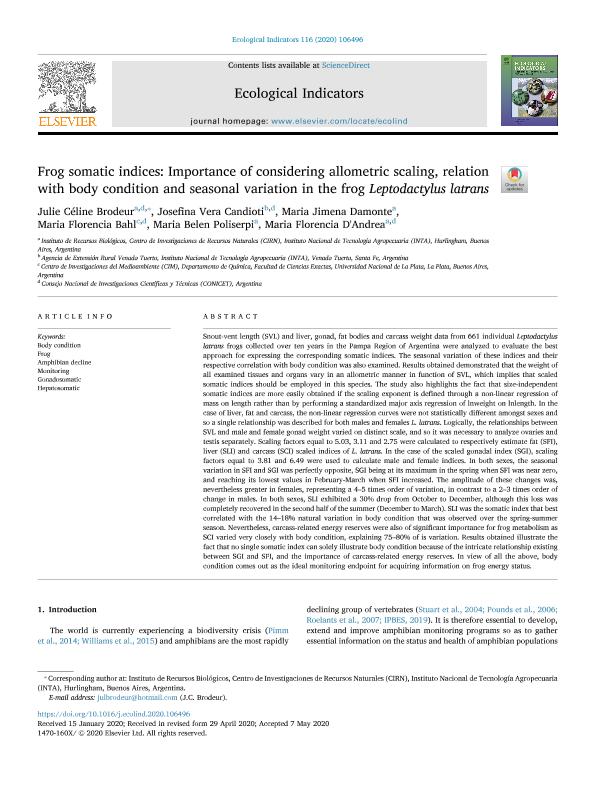Mostrar el registro sencillo del ítem
dc.contributor.author
Brodeur, Celine Marie Julie

dc.contributor.author
Vera Candioti, Josefina

dc.contributor.author
Damonte, Maria Jimena

dc.contributor.author
Bahl, Maria Florencia

dc.contributor.author
Poliserpi, Maria Belen

dc.contributor.author
D'andrea, María Florencia

dc.date.available
2021-09-29T12:57:30Z
dc.date.issued
2020-09
dc.identifier.citation
Brodeur, Celine Marie Julie; Vera Candioti, Josefina; Damonte, Maria Jimena; Bahl, Maria Florencia; Poliserpi, Maria Belen; et al.; Frog somatic indices: Importance of considering allometric scaling, relation with body condition and seasonal variation in the frog Leptodactylus latrans; Elsevier Science; Ecological Indicators; 116; 9-2020; 1-9
dc.identifier.issn
1470-160X
dc.identifier.uri
http://hdl.handle.net/11336/141837
dc.description.abstract
Snout-vent length (SVL) and liver, gonad, fat bodies and carcass weight data from 661 individual Leptodactylus latrans frogs collected over ten years in the Pampa Region of Argentina were analyzed to evaluate the best approach for expressing the corresponding somatic indices. The seasonal variation of these indices and their respective correlation with body condition was also examined. Results obtained demonstrated that the weight of all examined tissues and organs vary in an allometric manner in function of SVL, which implies that scaled somatic indices should be employed in this species. The study also highlights the fact that size-independent somatic indices are more easily obtained if the scaling exponent is defined through a non-linear regression of mass on length rather than by performing a standardized major axis regression of lnweight on lnlength. In the case of liver, fat and carcass, the non-linear regression curves were not statistically different amongst sexes and so a single relationship was described for both males and females L. latrans. Logically, the relationships between SVL and male and female gonad weight varied on distinct scale, and so it was necessary to analyze ovaries and testis separately. Scaling factors equal to 5.03, 3.11 and 2.75 were calculated to respectively estimate fat (SFI), liver (SLI) and carcass (SCI) scaled indices of L. latrans. In the case of the scaled gonadal index (SGI), scaling factors equal to 3.81 and 6.49 were used to calculate male and female indices. In both sexes, the seasonal variation in SFI and SGI was perfectly opposite, SGI being at its maximum in the spring when SFI was near zero, and reaching its lowest values in February-March when SFI increased. The amplitude of these changes was, nevertheless greater in females, representing a 4–5 times order of variation, in contrast to a 2–3 times order of change in males. In both sexes, SLI exhibited a 30% drop from October to December, although this loss was completely recovered in the second half of the summer (December to March). SLI was the somatic index that best correlated with the 14–18% natural variation in body condition that was observed over the spring-summer season. Nevertheless, carcass-related energy reserves were also of significant importance for frog metabolism as SCI varied very closely with body condition, explaining 75–80% of is variation. Results obtained illustrate the fact that no single somatic index can solely illustrate body condition because of the intricate relationship existing between SGI and SFI, and the importance of carcass-related energy reserves. In view of all the above, body condition comes out as the ideal monitoring endpoint for acquiring information on frog energy status.
dc.format
application/pdf
dc.language.iso
eng
dc.publisher
Elsevier Science

dc.rights
info:eu-repo/semantics/openAccess
dc.rights.uri
https://creativecommons.org/licenses/by-nc-nd/2.5/ar/
dc.subject
AMPHIBIAN DECLINE
dc.subject
BODY CONDITION
dc.subject
FROG
dc.subject
GONADOSOMATIC
dc.subject
HEPATOSOMATIC
dc.subject
MONITORING
dc.subject.classification
Otras Ciencias Naturales y Exactas

dc.subject.classification
Otras Ciencias Naturales y Exactas

dc.subject.classification
CIENCIAS NATURALES Y EXACTAS

dc.title
Frog somatic indices: Importance of considering allometric scaling, relation with body condition and seasonal variation in the frog Leptodactylus latrans
dc.type
info:eu-repo/semantics/article
dc.type
info:ar-repo/semantics/artículo
dc.type
info:eu-repo/semantics/publishedVersion
dc.date.updated
2021-04-23T19:04:25Z
dc.journal.volume
116
dc.journal.pagination
1-9
dc.journal.pais
Países Bajos

dc.journal.ciudad
Amsterdam
dc.description.fil
Fil: Brodeur, Celine Marie Julie. Consejo Nacional de Investigaciones Científicas y Técnicas. Centro Científico Tecnológico Conicet - La Plata; Argentina. Instituto Nacional de Tecnología Agropecuaria. Centro de Investigación de Recursos Naturales. Instituto de Recursos Biológicos; Argentina
dc.description.fil
Fil: Vera Candioti, Josefina. Consejo Nacional de Investigaciones Científicas y Técnicas. Centro Científico Tecnológico Conicet - La Plata; Argentina. Instituto Nacional de Tecnología Agropecuaria. Centro Regional Santa Fe. Estación Experimental Agropecuaria Oliveros. Agencia de Extension Rural Venado Tuerto; Argentina
dc.description.fil
Fil: Damonte, Maria Jimena. Instituto Nacional de Tecnología Agropecuaria. Centro de Investigación de Recursos Naturales. Instituto de Recursos Biológicos; Argentina
dc.description.fil
Fil: Bahl, Maria Florencia. Universidad Nacional de La Plata. Facultad de Ciencias Exactas. Centro de Investigaciones del Medio Ambiente - Consejo Nacional de Investigaciones Científicas y Técnicas. Centro Científico Tecnológico Conicet - La Plata. Centro de Investigaciones del Medio Ambiente; Argentina
dc.description.fil
Fil: Poliserpi, Maria Belen. Instituto Nacional de Tecnología Agropecuaria. Centro de Investigación de Recursos Naturales. Instituto de Recursos Biológicos; Argentina
dc.description.fil
Fil: D'andrea, María Florencia. Consejo Nacional de Investigaciones Científicas y Técnicas. Centro Científico Tecnológico Conicet - La Plata; Argentina. Instituto Nacional de Tecnología Agropecuaria. Centro de Investigación de Recursos Naturales. Instituto de Recursos Biológicos; Argentina
dc.journal.title
Ecological Indicators

dc.relation.alternativeid
info:eu-repo/semantics/altIdentifier/url/https://linkinghub.elsevier.com/retrieve/pii/S1470160X20304337
dc.relation.alternativeid
info:eu-repo/semantics/altIdentifier/doi/http://dx.doi.org/10.1016/j.ecolind.2020.106496
Archivos asociados
